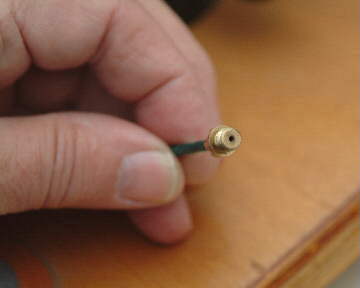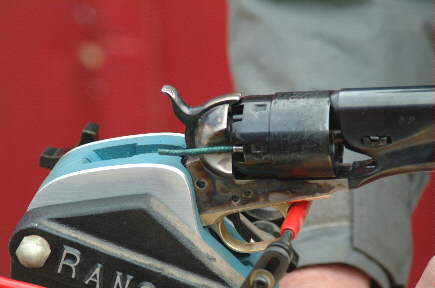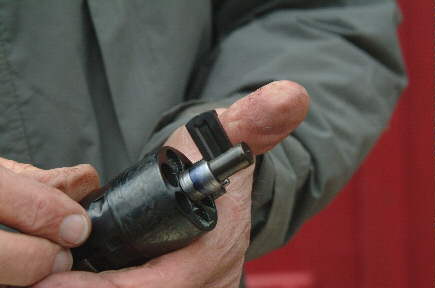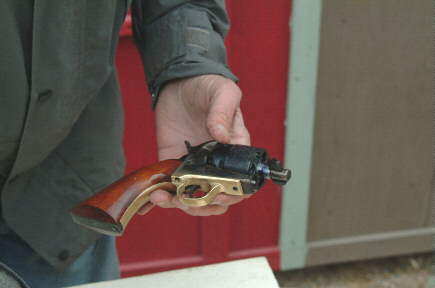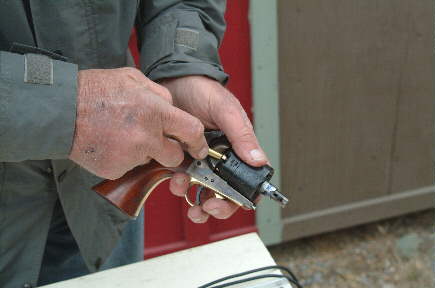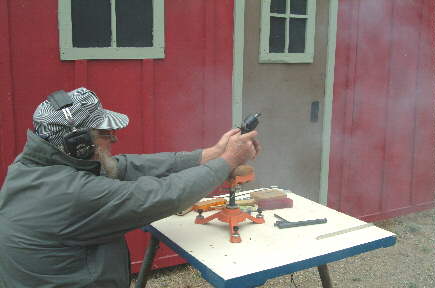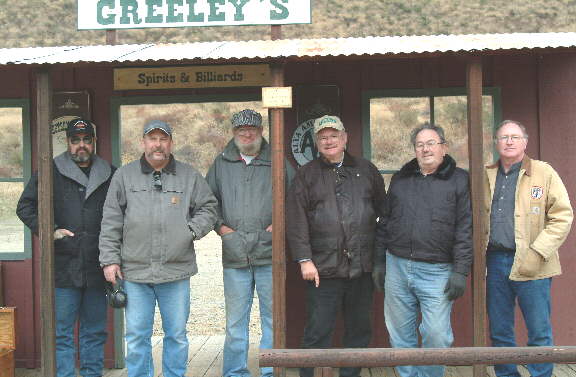| Capping
the Percussion Revolver by Old Scout
The proper method of attaching percussion caps to the C&B revolver, in preparation for firing, has been the subject of much discussion of late. To help resolve this issue, the Brimstone Pistoleros recently ran a series of tests, on several different models of C&B revolvers. The revolvers chosen to evaluate
were the Colt M 1860, Remington M 1858, Rodgers & Spencer M 1865,
and the Ruger Old Army. Examination of these four revolvers brought
to light that the Rodgers & Spencer and the Ruger Old Army are designed
in such a way that if a chamber were to discharge at the capping position
(90° to the right of the barrel), the ball, leaving the chamber would
have no contact with any part of the arm. The Colt and Remington
designs, on the other hand, do have points of interference between a ball
launched from a chamber in the capping position and the frame or other
part of the arm. Figures 1 and 2 show the Rodgers & Spencer and the
Ruger clearance.
When the percussion caps are placed on the nipples of a C&B revolver, it is the habit of most shooters to apply some amount of pressure to the cap to “seat it” on the nipple. This practice helps to eliminate misfires. If the combination of nipple and cap is correct then only a very slight pressure is required to seat a cap reliably. On today’s shooting ranges you will see three different approaches to the cap seating matter. Some shooters will apply thumb or finger pressure to seat the cap. Another group will install the caps on the nipples and then rotate the cylinder while using the hammer of the firearm to press on the caps. The last group are those shooters that install the caps on the nipples and then use a “Push Stick” to seat the caps at the capping position (90° to the right of the barrel, at the cutout in the recoil shield). The basic question that we have set out to answer is “which method of seating caps affords the greatest range safety?” On a recent Saturday, a crew arrived
at the range with a truck load of equipment and guns. The first order of
business was to set up a test cell. Figure 3 shows the screen being built.
A position was established for the firearm, and then a screen of clean
cardboard was constructed to show evidence of any material leaving the
firearm. The screen is at a radius of about 4 feet from the revolver. The
revolver was mounted in a “Ransom Rest” (machine rest) so that the P.O.A.
would remain fixed. Figure 4 depicts mounting the Colt in the rest, and
figure 5 shows the test cell ready for the first shot.
For the entire test, all chambers were loaded the same. The standard charge was 28 grs. of GOEX fffg powder followed by a Wonder Wad, and a Hornady swaged ball of .454” diameter. All caps used were of Remington make. The first step in the proceedings was to fire a normal shot from the gun under test. This shot was fired to establish the P.O.A. of the firearm. Upon resetting the machine rest, a second shot was fired from the cylinder, while in the capping position (90° to the right of the barrel). At this point it was possible to examine the screen for shrapnel, particles, or any other matter that might pose a hazard to shooters in the area. In figure 6, the Colt 1860 is seen
being fired , with a normal charge, through the barrel. Note the upward
recoil of the revolver in the machine rest, denoting considerable energy
in the discharge.
The second phase of testing was to
fire a charge from the cylinder, out of battery, in the capping position.
Figure 7 documents this experiment. Discharging the cylinder produced virtually
no pressure, the powder charge burned beside the firearm in the open air.
The cameraman was standing roughly where another shooter might be and was
not distressed by the little poof of smoke and sparks. Examining the “screen”
failed to indicate the presence of any particles, other than the ball.
While the ball struck the frame of the firearm, it did not fragment or
produce any form of shrapnel. The ball was deflected slightly to the right
of the P.O.A. Figure 8 was taken after both the Remington and the Colt
revolvers had both been tested. It can readily be seen in the picture that
both “normal” shots struck within about 1” of each other. The shot being
measured with the tape is from the Remington. This ball was deflected about
7” by contact with the arm. The other hole, another 4” or so farther to
the right is the Colt impact point.
At this point it is obvious that
an out of battery discharge, that is having a chamber fire while in the
capping position will not expose the adjacent shooters to any great danger.
The next question was one of energy.
Does the out of battery discharge pose a threat at some distance? To answer
this question an additional set of tests were performed. The Colt revolver
was fired, 5 shots, loaded normally and fired through the barrel. The chronograph
established the normal muzzle velocity to be 852 ft per sec. The barrel
was then removed from the Colt, figure 9-11 and the arm was fired from
the cylinder only. The velocity of a ball discharged from the cylinder
was found to have a velocity of 146 ft per sec.
Using the standard Kinetic Energy
equation, we may find the energy of the balls.
Readers who have studied small arms ballistics to any extent will be aware that the ball from the muzzle of our test gun, with an energy of 238 ft/lbs is a DEADLY projectile. While the ball from the cylinder is to be sure, dangerous, I would not class it as deadly. I have not yet tried this experiment, but I believe a person with a good right arm could throw a bullet hard enough to approach the energy of the ball fired from the cylinder (as loaded and fired in our experiments). Keeping our test data in mind, lets now consider the various cap seating methods mentioned above. Viewed with an eye to general safety of all shooters in the proximity of the loading bench at a typical CAS event. Case one, the seating of caps with thumb or finger pressure (or any other body part). The ignition of a cap while seating it, seems to be a very remote occurrence (I can only find three cases that may be true). In order to press the cap with the thumb, the revolver will generally be held parallel to the loading bench or muzzle somewhat down. A ball launched from the cylinder in this position will pose a minimum threat to other shooters. The thumb or finger used to seat the cap will likely require medical attention. The explosive force of a percussion cap is considerable. Case two, the use of the hammer to seat caps. This is without doubt, a most dangerous practice. A visit to most any CAS range will present an array of loading tables with bullet holes, and chunks of wood blown away by the accidental discharge of a firearm while loading. The vast majority of these ADs are from handguns, discharged while attempting to index them. The act of seating caps with the hammer is an accident waiting to happen. The probability of a “slipped hammer” accidental discharge is extremely great. Such an accident will loose a full energy projectile! I can think of no greater hazard to the other shooters in the area (It is also a basic violation of SASS policy to lower the hammer on a loaded chamber). Case number three, the use of a “push stick” seems to offer the greatest overall range safety. If a chamber discharge did occur , the projectile from the “out of battery” position will have very little energy, and therefore be less likely to do serious harm to another shooter in the area. Further the use of a “push stick” will keep the hand of the shooter loading the firearm, in a much safer location. After consideration of all the data, the “Brimstone Pistoleros”, a SASS affiliated club, a SASS affiliated club have adopted the standard range rule that caps, installed on a C&B revolver, may only be “seated” with the use of a “push stick”. Old Scout
|









